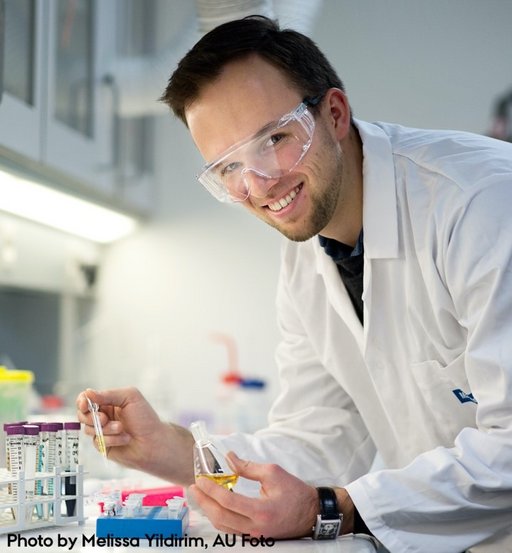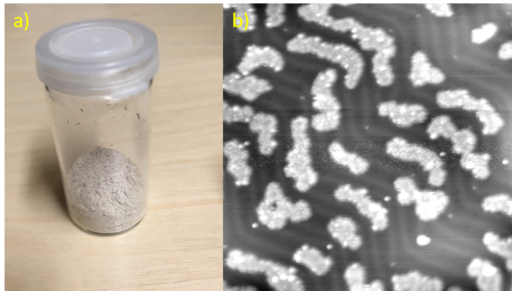Aarhus University
Functional magnets and catalyst materials form the basis of the research conducted by the six SMART Project PhD students hosted at Aarhus University. Discover more about the students and their research on this page.
Complex borohydride derivatives as solid state electrolytes - Mads Blichfeldt Amdisen
To accommodate the intermittent nature of sustainable energy sources such as wind and solar power, it is necessary to develop new storage capabilities. During Mads' five-year PhD scholarship under the supervision of Prof. Torben R. Jensen his research will be centered on developing and characterizing complex metal hydride-based materials for post lithium-ion all-solid-state batteries, both to meet the needs for energy storage and to improve the safety of batteries. Rational design of battery materials heavily relies on understanding their properties on atomic to macroscopic scale. Crystal structures, ionic conductivity mechanisms, and electrochemical stability are just some of the properties that need to be determined. A large variety of complimentary characterization techniques including X-ray and neutron scattering techniques, DFT calculations, solid-state NMR, FT-IR, and electrochemical impedance spectroscopy are necessary to obtain an understanding of the fundamental properties of new battery materials.
Single crystal growth and 3D-PDF studies of magnets with correlated disorder - Jonas Ruby Sandemann
The intrinsic properties of crystals are determined by their atomic structure, which for most materials has long-range order – they are crystals. However, when like atoms do not have exactly the same position in each unit cell, the crystal is disordered. It is increasingly clear that subtle disorder controls many of the essential properties of advanced materials such as magnetism. A good example of disorder dictating properties is a frustrated magnet, where the symmetry of the crystal lattice prevents long range ordering of the magnetic moments in the material resulting in exotic magnetic phases such as spin liquids or spin glasses. Prof. Bo Brummerstedt Iversen is pioneering in this field of research.
Jonas' research in the Brummerstedt Iversen group consists in growing pristine single crystals of materials exhibiting atomic and/or magnetic disorder in order to perform high resolution crystallographic studies using x-ray and neutron scattering. This will allow us to gain insight in both the average structure and, through methods such as 3D-PDF, the local deviations from this, in order to better understand disorder and its effect on the physical properties of materials.
In situ Characterization of Functionalized Carbon and Metal-sulfide Electrocatalysts - Jens Jakob Gammelgaard
With the current transition to renewable energy and sustainable production, the technique of electrocatalysis holds great promise. Electrocatalysis utilizes electricity and precisely controlled reactions to generate chemical products. However, electrocatalysis is generally not viable for industrial usage yet. The amount of energy needed to drive the reaction varies greatly depending on the used electro catalyst, and typically, the energy cost does not allow for cost-effective usage.
Jens Jakob's project studies materials for electro catalysis in order to optimize them under the supervision of Assoc. Prof. Jeppe Vang Lauritsen. For optimization, we need to gain an in depth understanding of the materials, typically functionalized carbons. The materials is prepared both as a powder and as a 2D monolayer on top of metal crystal. This varied preparation enables a varied set of characterization techniques, from powder diffraction to scanning tunneling microscopy.
The hope is to combine these in-house characterization techniques with a range of powerful x-ray techniques available at MAX IV. Here we hope to use the 2D system for operando x-ray photoelectron spectroscopy studies of electrochemistry and the powder system for operando measurements of x-ray absorption spectroscopy and the pair distribution function. These experiments will give a detailed understanding of both the material and the reactions that take place during electro catalysis.
Texture analysis of magnetic materials - Mathias Mørch
Mathias Mørch is a PhD student in Assoc. Prof. Mogens Christensen's group and his work is focused on textured nanomagnets. Before starting his PhD, Mathias completed his Masters degree in Nanoscience, where he worked with powder diffraction and magnetic crystallography. He is greatly interested in exploring advanced powder diffraction methods, and this project on textured nanomagnets, is a possibility to do this.
When studying texture, the information available from the azimuthally varying intensity in a diffraction ring is fully leveraged. This requires dividing a traditionally summed diffraction image into multiple sections. Analysis of these sections must depend on both the information within a section, but also the azimuthal variation that contains texture information.
Mathias is studying a sub-group of magnetic materials, hexaferrites, with combined Rietveld refinement and texture analysis to investigate the interplay between crystal structure, morphology and texture and how these three all effect the magnetic properties.
Maximizing magnetic anisotropy in single molecule magnets – synthesis and polarized neutron powder diffraction methods development - Andreas Munch Thiel

Andreas received his Master’s degree in chemistry at Aarhus University in 2019, and after a brief period as a research assistant on the LINX project he then started his PhD-project in the field of single-molecular magnetism at the group of Assoc. Prof. Jacob Overgaard. Andreas' research involves the synthesis and characterization of single-molecule magnets (SMMs), primarily using X-ray and neutron diffraction methods.
The field of single-molecule magnetism is in rapid development, and it is quite exciting to be a part of the research being done at the very edge of our scientific capabilities. If the properties of SMMs can be improved and fully understood, it could be used to significantly advance our current data storage technologies. One of the major projects of my PhD is developing and utilizing the method of polarized neutron powder diffraction (PNPD) to investigate the magnetic anisotropy of SMM’s, a parameter that can be directly related to their magnetic properties. Other parts of my research include synthesis of novel SMM frameworks, high-pressure single-crystal X-ray (HP-SCXRD) crystallography and neutron diffraction characterization.



